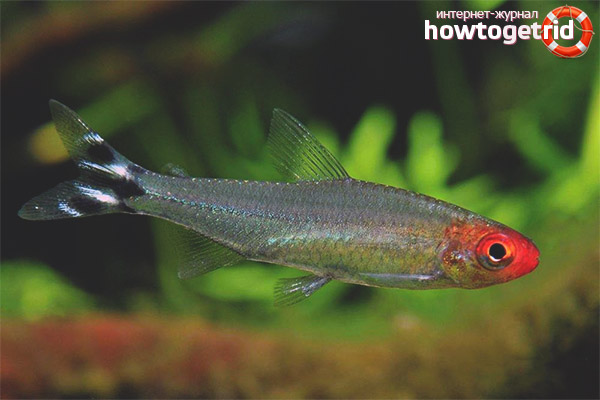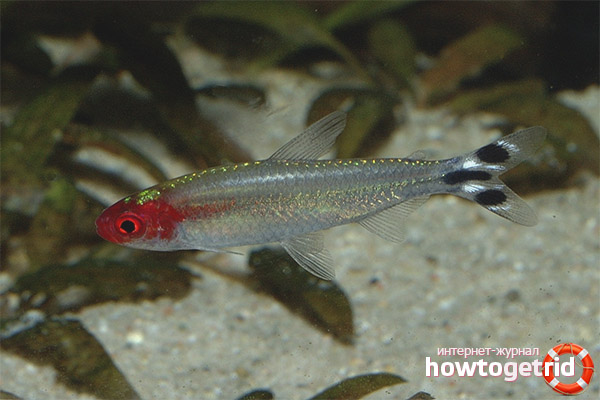The content of the article
The aquarium fish rhodostomus also has the name red-nosed tetra. In Latin, its name sounds like Hemigrammus rhodostomus. And it looks very impressive against the background of other inhabitants in the aquarium. A red spot is located on her head, the rest of the body is silver in color. On the caudal fin of representatives of this species, black and white stripes. The rhodostomus has a length of 4.5 centimeters. Due to its peaceful nature, this fish can be kept with any other peaceful species.
The name "red-nosed" she received due to a spot on her head. Nevertheless, in the CIS countries it is more often called a rhodostomus.
Rodostomus contain flocks. They will feel good if there is a large amount of algae in the aquarium. In order for the fish to have a beautiful color and be active, it is necessary to create conditions close to natural for it. Rhodostomuses live in soft water with high acidity. Due to the large amount of organic matter, the water in these reservoirs is dark. It’s better to run these fish in such an aquarium, where the water has already returned to normal.
These fish are pretty demanding on conditions. If any water parameters do not suit them, it immediately becomes clear. Fish fade, do not behave as usual. Most likely, they will experience the first days in the new aquarium quite hard. Therefore, you need to wait a while for them to get used to. Soon they will become as bright and active.
Living in nature
Description
The appearance of these fish makes many people want to get them in their aquarium. The rhodostomus has an elongated graceful body. The length of an adult is about 4.5 cm. They live about 5 years. The most attractive feature of this beautiful fish is the presence of a red spot located on its head. Hence its second name is the red-headed tetra.
Content Issues
Rhodostomus is recommended for those who have some experience in keeping fish. After all, they are very capricious and demanding. It is important that the water always remains clean, there are no harmful substances, ammonia, nitrates in it. The remaining parameters should also match the preferences of the rhodostomus. If you are preparing a new aquarium for them, you need to wait until all the parameters in it are normalized, and then start the fish. water should be soft and acidic (it is necessary to adhere to such parameters ph: 5.5-6.8, 2-8 dGH). Also, experts recommend having an external filter.
Feeding
You can feed these fish with any food. They will eat frozen, artificial, as well as live food. Sometimes you can give them a pipe maker and bloodworms, high-quality flakes. It is important that the feed is shallow, as these fish have a small mouth.
Content
Since rhodostomuses in nature like to live in flocks, in the aquarium they will feel sowing much better in a group of 7 or more individuals. Such flocks usually establish a hierarchy. As a result, each fish reveals its beautiful color. To contain a small flock, it will be enough to buy an aquarium of about 50 liters. Compared to other tetras, rhodostomuses are very moody in terms of water. pH should be 5.5-6.7. It is necessary to provide them with soft acidic water.It is important to control that the amount of nitrates and ammonia does not increase, therefore, the presence of an external filter is desirable. The light should not be too bright. Soft light will make the fish feel that they are in their natural environment. Over the rivers in which the rhodostomuses live, there are dense crowns of trees.
An ideal option to create an aquarium for these tetras is a biotope. Various driftwood, foliage, sand are suitable for decoration. This decor will be very close to the natural habitat. Tetra will feel as comfortable as possible.
Each week a quarter of the water should be replaced with fresh water. The ideal temperature for them would be 23-28 degrees. Since the fish are shy enough, it is better to put the aquarium in a quiet place where people will not pass too often.
If the fish begins to darken and fade, this indicates that the living conditions in the aquarium have changed. Most likely, the level of harmful substances in the water has risen significantly.
Compatibility

Due to the peacefulness of these fish, they can be kept together with other species. But with large and predatory fish they do not need to be settled, as tetras can become victims. They are perfectly combined with cardinals, thorns, erythrosonuses.
Gender differences
In appearance, they practically do not differ. The only difference is the more rounded abdomen of females. In males, it is smaller.
Breeding
Breeding rhodostomuses is not easy. Even an experienced aquarist may not be able to handle this. Difficulties are associated with two points.
- If the fish grew in water with a high level of hardness, then the caviar will not fertilize.
- If nevertheless it was possible to remove the fry, then they will grow slowly. Until spawning begins, it is extremely difficult to accurately determine the sex of an individual.
It is very important that spawning is clean. An ultraviolet sterilizer must be installed in the filter. This is due to the fact that there is a high probability of infection of eggs with various bacteria or fungi. After spawning, antifungal drugs must be added to spawning.
Those who want to breed rhodostomuses should know a few rules well in advance of how the spawning period begins. When growing producers, the conditions must be strictly observed. All their lives, fish should grow in acidic water with low hardness. Only in this case they will be able to give offspring. If this condition has not been met, then starting breeding is useless. Such fish will definitely not give offspring. To create good conditions in spawning, it is recommended to add peat to it. For the producers to be in good shape, before spawning, it is better for them to give only live food.
In nature, these fish spawn in small-leaved plants. They are very difficult to find. In addition, most of them grow only in bright light. Which is contraindicated for successful spawning. Therefore, the best option here would be synthetic threads or Javanese moss.
One week before the expected date of the start of spawning, it is necessary to transplant the fish into the spawning. It should have a dim light. During this period, fish should be fed only with live food. The aquarium should be in a very calm place. The temperature must be raised gradually. It should reach 32 degrees. Spawning occurs almost in the twilight. Therefore, to see caviar, a flashlight is usually used.
Unlike other tetras, representatives of this species will not eat caviar. But it’s better to transplant them from the aquarium. It is important that antifungal agents are constantly in the water. Otherwise, caviar infection may occur. Bright light should not be allowed to spawn.
Even if the aquarist has overcome the difficulties of breeding these fish, then he is faced with another problem.As already mentioned, fry of this species grow very slowly. Among all aquarium fish, they are almost the slowest growing. Within 12 weeks, the fry are fed with small feed. Only after that it will be possible to switch to large. In order to quickly transfer fry to large feed, it is necessary to maintain the water temperature above 30 degrees. This temperature is necessary for the fry as long as possible, otherwise they may get sick.
Often it takes about six months to transfer fry to such a large feed as daphnia. If from these fry you also want to get posterity in the future, then throughout their life it is necessary to strictly monitor the water conditions. In the first months, it should be acidic, soft and very clean. Breeding these fish is recommended for the most experienced aquarium lovers. But with a great desire, this can be achieved by a beginner. The main thing is that he take this task with all seriousness.
Video: red-nosed tetra (rhodostomus)










Submit